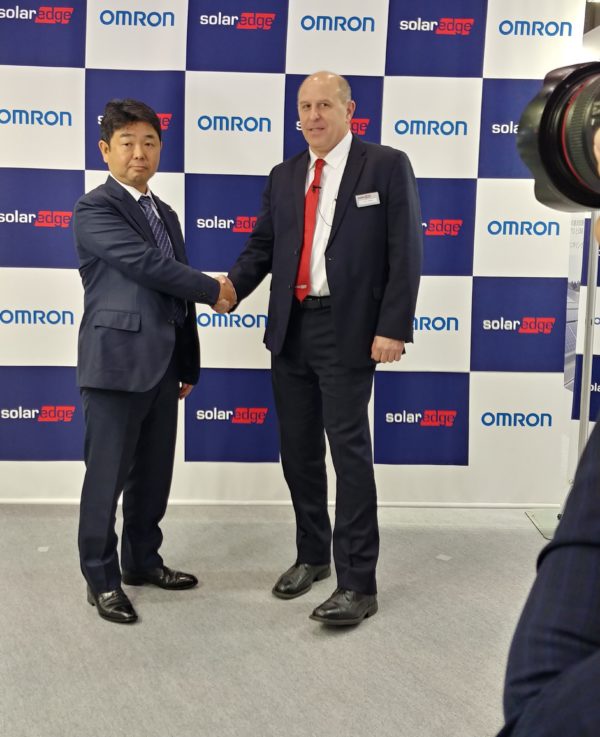Spread over three days and several exhibits, World Smart Energy Week 2019 attracted 66,579 visitors to Tokyo’s Big Sight Conference Center, according to show organizer Reed Exhibitions Japan.
Throughout the event, discussions about Japan’s domestic market focused on the shift to residential installations and the rising popularity of self-consumption. Both trends are policy driven – courtesy of the pending drawdown of generous feed in tariffs and shift to an auction system for utility-scale projects – and will bring a shift in business models and technology for many companies.
Not long after the curtain went up, Israeli company SolarEdge announced plans to extend its partnership with Omron by granting exclusive single-phase inverter marketing rights in the country to its Japanese partner. In a press conference at PV Expo, SolarEdge Technology’s VP of global sales, Zivi Lando, said the partnership would seek to provide additional value to FIT projects before the incentives scheme winds down, and to help the growth of new models such as self-consumption.

The move toward self-consumption was evident in many of the products on show. Companies including Korea’s Hanwha Q Cells moved for the first time to the ‘smart grid’ section of the exhibition, demonstrating a full rooftop system including inverter and battery storage. Plenty of other self-consumption solutions were visible too, with domestic titans Sharp and Panasonic demonstrating sophisticated solutions for home energy management that incorporated electric vehicle charging and management of home appliances.
Module innovations
While Japanese companies were plentiful, it was China’s module manufacturing giants which had the biggest presence on the show floor at PV Expo. Jinko Solar used the event to launch its new bifacial module, which features a transparent PVF backsheet developed by DuPont. Jinko chief scientist Hao Jin told pv magazine the transparent backsheet offers lower reflection than glass, and the module offers a solution to well documented problems with glass-on-glass frameless module installation.
Meanwhile, DuPont had big expectations for its transparent backsheet, with Oakland Fu, the U.S. company’s business development manager for PV, pointing out it is attractive to manufacturers who will be able to switch to the transparent material without making changes to production lines.
Many manufacturers, however, demonstrated glass-to-glass bifacial products. PERC [passivated emitter rear contact] cells continue to be the production focus for most manufacturers, although half cut cells are gaining ground. Shingled cell and multi busbar concepts on display at the booths of virtually all leading manufacturers, meanwhile, provided a glimpse into the possible future of manufacturing.
Popular content
Utility-scale
While there was a lot of talk about Japan’s shift toward residential and self-consumption, the country still boasts a large utility-scale pipeline. As the Ministry for Economy, Trade and Industry (METI) has set deadlines for such projects to qualify for the FIT – next March for projects with a capacity smaller than 2 MW, and September 2020 for projects that are bigger than 2 MW – Tokyo-based analyst RTS Corporation expects up to 7 GW of new PV to come online in Japan this year.
And while the tendering system set to replace FITs has been slow to get off the mark – with initial auctions failing to produce competitive prices – METI expects improvement this year, and is targeting 750 MW of new PV from tenders.
Booming batteries
If the scale of solar at the exhibition was down on previous years, a walk over to the battery expo at the other side of the conference center showed things are moving much faster.
With the industry expecting a major demand spike from electric vehicles, battery manufacturing was a hot topic, and a visit to the Expo’s Germany pavilion revealed several equipment suppliers taking PV sector experience into battery production.
They included Von Ardenne, which has developed a passivation process for aluminum foil which it says can increase battery stability and allow for the use of further electrolyte systems. CEO Christian Knechtel noted, while battery manufacturing is dominated by China, there are plenty of Japanese companies in on the act. That is particularly true of carmakers although the planned expiry of Japan’s residential FIT is likely to prompt a boom in residential battery demand, as PV system owners will no longer receive payments for exporting energy to the grid, and will look to retrofit storage.
This content is protected by copyright and may not be reused. If you want to cooperate with us and would like to reuse some of our content, please contact: editors@pv-magazine.com.



By submitting this form you agree to pv magazine using your data for the purposes of publishing your comment.
Your personal data will only be disclosed or otherwise transmitted to third parties for the purposes of spam filtering or if this is necessary for technical maintenance of the website. Any other transfer to third parties will not take place unless this is justified on the basis of applicable data protection regulations or if pv magazine is legally obliged to do so.
You may revoke this consent at any time with effect for the future, in which case your personal data will be deleted immediately. Otherwise, your data will be deleted if pv magazine has processed your request or the purpose of data storage is fulfilled.
Further information on data privacy can be found in our Data Protection Policy.